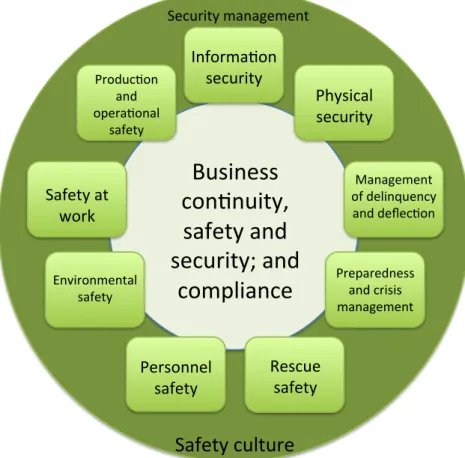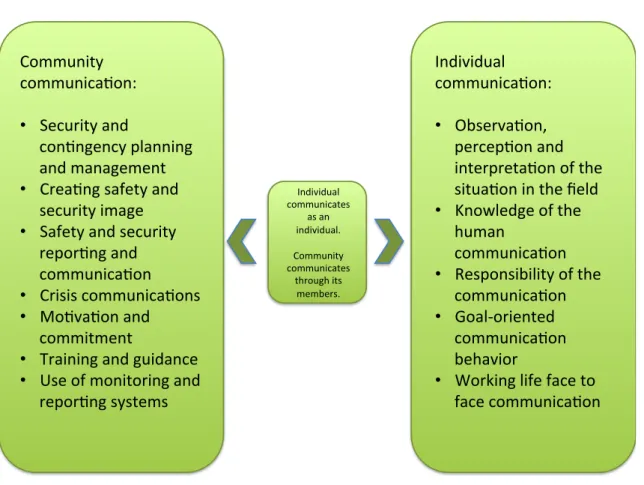General safety management in hospitals, legislation and safety culture formed the main theoretical concepts of this thesis. The theoretical background of this thesis is formed in the interconnection of legislation, safety culture and safety management.
Operating environment
Safety culture is reflected in the organization's basic values, norms, assumptions and expectations (Työsuojelu web page, 2017). Therefore, generating and developing a security culture is important to service users to achieve a true security image in the organization.
Excisting operating model/guide
Cooperating organization
Research question and objectives
The objective of this thesis is to develop an operational model for serious violence. This thesis presents the operating model and development methods for hospital safety and security considering serious violence.
Hospital safety and security
Physical security aims to create an intrusion-free and secure work environment and prevent the theft of the organization's valuable information or material. Rescue safety refers to the prevention of fires or other accidents, as well as the rapid and appropriate response in the event of an accident. Personnel security is designed to ensure the safety and stability of people by protecting them from crime and accidents.
The goal of occupational health and safety is safe work, the well-being of employees and thus a good and responsible image of the company. All in all, hospital safety and security, like any other corporate security, is a vast field that requires expertise in total safety and security. A well-planned strategy and risk management along with safety management create the foundation and guidelines for hospital safety and security.
Creating a safety culture and everyone's commitment to these guidelines is critical to achieving business continuity, complete safety and security, and compliance, which are key areas in the hospital industry. Dedicated safety management and training methods are methods to increase safety and security in hospitals (Komokallio, interview).
Severe violence in hospitals
Targeted security management and training methods are methods to increase the safety and security of hospitals (Komokallio, interview). to the hospital and one in the hospital. Even in this case, the motive is not known, nor was the hospital a target for any reason or random attack. Of course, as with all other violence faced by hospital staff, there are instances that are predictable and therefore preventable.
For the above reasons, the violent person and the causative cause can be difficult to predict.
Safety culture
In other words, safety culture is observing and paying attention to your surroundings and work environment and communication. The next chapter will present an idea of how to approach this thesis and what is the outcome of the process. The goal of the thesis is to develop an already existing guide into a functional thesis.
Two different methods, literature search and interview, were used for the empirical data collection of this thesis. This overview gave a thorough picture of the current state of preparedness for serious violence in hospitals. Most of the articles used are not Finnish articles, mainly because specialists in Finland have not studied this problem very well.
For the reason mentioned in the previous chapter, that Finns are not yet specialized in this area, data collection included only one interview. The idea of the interview was to understand the needs for smooth cooperation between hospitals and authorities in serious violent attacks. It will explain how the data was collected through literature and interviews, and how the received data and knowledge was analyzed.

Literature review
The guide covers the legislation quite thoroughly, which gave this thesis a good starting point to look at the subject from a legislative point of view. The guide gave a good overview of the legislative requirements, or lack thereof, considering the topic. The legislation read from the guide and further reading about legislation that considers occupational safety provided a solid basis for the whole process and some theoretical background.
The guide focuses on a very different environment than this thesis is about, but still contains some basic ideas about human behavior in stressful situations, risk-based thinking and the need for indoor shelter. Because the guide was written to be compatible with educational institutions, it is not entirely consistent with the philosophy of this dissertation. The beginning of the guide also dealt with human behavior under stressful conditions, and in particular elements that guide the choice of escape route.
Ignoring emergency exits creates a fundamental problem in an emergency for the proper type of operation. A number of literary sources, as well as an interview for this thesis, gave the opinion about the importance of communication. The sixth paragraph of this study goes through further communication from the perspective of developing safety and security in hospitals.
Interview
The data were analyzed in the interview phase, to strengthen and clarify the interpretation of the interview. Another important thought that the layperson considered during the interview was the amount of different models and operating instructions. In any situation threatening violence must be able to make an initial assessment of the criticality of the situation.
Assessment of the situation at the outset is also essential to avoid unnecessary actions and ensure business continuity without unnecessary disruptions. Evacuation looking away from threat and out of the building using emergency exits is always the preferred approach, but especially in a hospital setting, unnecessary evacuation carries over. In the end, the management of the situation is with the police, but the police are rarely there at the initial situation.
To conclude the interview, it gave a perspective on the practicalities related to the governance model and the development of hospital safety and security. Discussion of the use of the business model follows its actual presentation. It will also present the possible development methods that emerged during this thesis process.
Operating model
The following chapters present all the phases of the model in detail based on the theme interview and discussions with hospital security specialist. It is important to get yourself to a safe place first and then help others if possible. If it is a non-targeted, random attack, the attacker will not take the time to break through.
People can only take shelter indoors because they are unable to choose a safe escape route, even if there is one. It is important to inform the authorities of the situation as soon as possible. If it is safe to notify hospital security after the emergency call, this should be done.
Full or dynamic blockade and evacuation are possible actions depending on the type and location of the attack. However, it is good to note, in the words of Ranta and Martikainen (2016, 7), that in the most extreme acts of violence, there is not a single approach, but a single principle: always away from the threat. It is designed to save lives and enable business continuity even after an initial attack.

Development methods for hospital safety and security
Security management
Safety management is comprehensive and targeted work to maintain and improve safety and health at the workplace, working conditions and working environment. The main factors of safety management are the organization and implementation of safety management in the organization. Preparedness in order to achieve the intended level of safety and security as well as for the possible threats and dangerous situations is considered a wise and realistic attitude.
As part of this, safety management communication should be multi-dimensional and not just one-way.
Training
In large organisations, such as HUS, where the number of staff is close to the population of the small municipality, it becomes difficult to train and maintain the skills for face-to-face training. Motivated and safety and security-oriented personnel are a channel for an improved safety culture and for maintaining the intended level of safety and security in the workplace. If each department/unit in each shift had a person "responsible for safety and security", it could be more trained on the subject than others.
The person should not be superior to the other in any way, but someone who is motivated to maintain, improve and develop safety and security in that department/unit. And the few people who are responsible for security in their department/unit cannot train the rest of the staff. Of course, not everything can be trained remotely, so face-to-face training should be organized for all staff, but online training can provide tools to deepen and retain the skills learned.
In general, basic face-to-face training for all personnel, which would review general safety and security guidelines and processes. Subsequently, the selected volunteer personnel responsible for safety and security in their department/unit would receive advanced training in maintaining and developing safety and security at work. In large organizations, even the training system explained above is not easily implemented, but it is still easier than face-to-face training and would make personnel more motivated and aware of safety and security at work.
Communication
Individuals must have an understanding of themselves as a communicator, as well as the purpose of the communication. The aim of the thesis was to develop and improve operational models for severe violent attacks on emergency hospitals. The thesis approached the issue from a slightly different perspective than most other studies in the same field.
Thesis aimed at layman-oriented thinking, which created operating models specifically for the use of laymen. This fact makes the operating model very practical to be used in almost all hospitals. Implementation of the operating model in practice mainly requires training and knowledge of the hospital's emergency plan, so that the choice of escape route is possible.
Further research in mind, a highly practical and highly functional research approach with particular focus on the operational model has demand. Gunman shot dead after rampage in German hospital https://www.theguardian.com/world/2010/sep/20/gunwoman-germany-hospital-rampage The Independent. Berlin hospital shooting: Patient shoots dead doctor before turning on himself. http://www.independent.co.uk/news/world/europe/germany-hospital-berlin-shooting-latest-.

